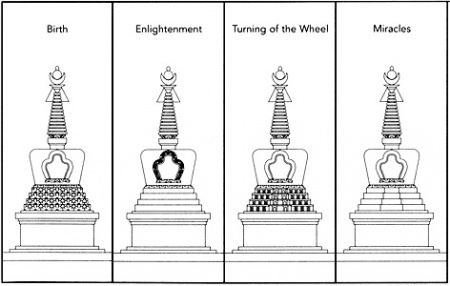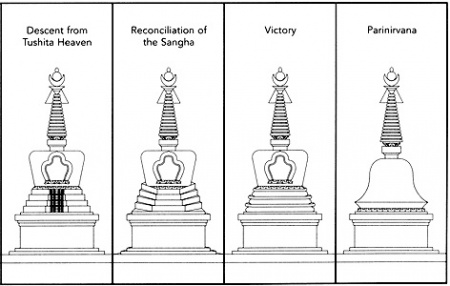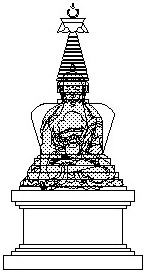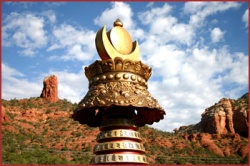What Are Stupas?
“Stupas began in pre-Buddhist India as hemispherical burial grounds that marked the remains of temporal rulers. At an early stage in the development of Buddhist art, they became symbols of the Buddha’s continuing immanence as well as representations of his Mind…..”
- Robert Thurman/Denise Leidy “Mandala, The Architecture of Enlightenment”.
Because every element of a Buddha’s physical body is pervaded with the pure energy of Enlightened Mind, the teacher’s remains after cremation are considered sacred. One sign that a teacher is an Enlightened manifestation is that relics will be found in the ashes that resemble small, round pearls which can be white, red, or brown. These are often the relics that are put inside stupas being built today.
8 Great Deeds
Since Shakyamuni Buddha’s passing, the stupas that have been built are representations of his form and memorials of his 8 Great Deeds. The structures are constructed according to guidelines found in Buddhist scripture that he left for us. Many stupas today are built on these representations.
After the Buddha took his last breath, and his body cremated, his ashes were divided into eight parts. Eventually, in order to share the blessings with the community, the kings and princes who were the caretakers of the relics built stupas to house them. Of the ancient stupas still intact today, most are said to contain relics of Shakyamuni Buddha.
In Tibetan Buddhism, the building of stupas (chorten in Tibetan) came to be an important part of the spiritual tradition.
The symbolism of the form of the stupas is a vast and complex subject, as is the meaning behind every item placed within a stupa. (sidebar). The shape of the stupa represents the Buddha, crowned and sitting in meditation posture on a lion throne. The stupa also symbolizes the five elements and colors and their relationship to Enlightened Mind:
- Base – Square – Yellow – Earth - Equanimity
- Dome – Circle – White – Water - Indestructibility
- Spire – Triangle – Red – Fire – Compassion
- Parasol – Half Circle – Green – Wind – All- accomplishing Action
- Jewel – Dewdrop (no shape/no color/void) – Space – All-pervading Awareness
The Moon/Sun shapes represent the union of compassion and wisdom, joining the all-accomplishing action of compassion with the all-pervading awareness of wisdom.
Different types of stupas have been built all over the world and can be as simple as burial mounds, to the elaborate pagodas of Myanmar, China and Japan.
A Stupa naturally establishes peace and harmony while subduing negative forces, like war and famine. It helps to prevent disease and balances the forces of nature as well as bringing blessings of health, prosperity and well-being to the community. No matter the shape or style, a properly constructed and consecrated stupa provides the world a place of blessing and spiritual refuge.
- “This stupa is called a Dharmakaya Stupa. Within it, the guru dwells unchanging. The Buddha said whoever sees a Dharmakaya Stupa will be liberated by the sight of it. Feeling the breeze nearby the stupa liberates one by its touch. The sound of the tinkling bells hanging on the stupa liberates by their sound. Thus, having seen or experienced this stupa, by thinking of one’s experience of it, one is liberated through recollection.”



